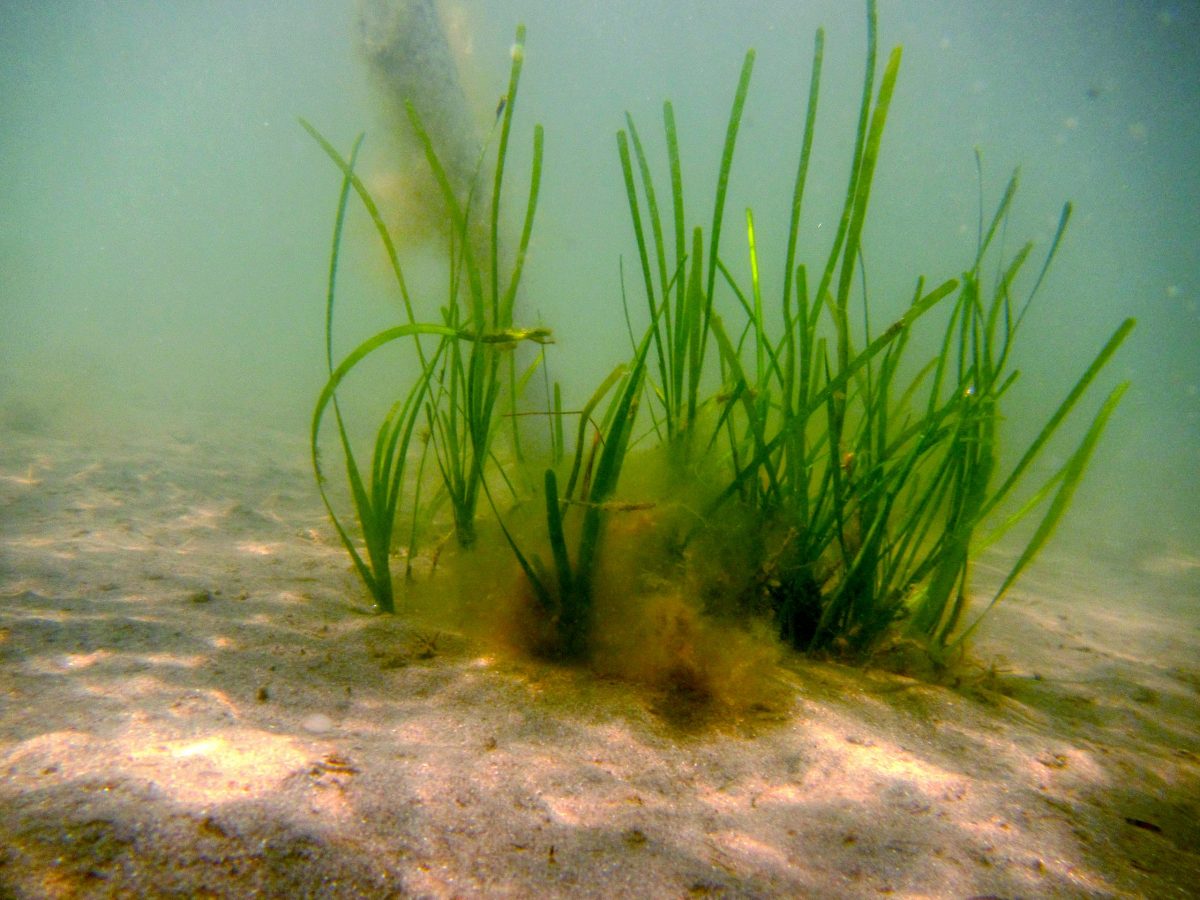Scotland's Coastal Restoration: Seagrass Planting Projects

Table of Contents
The Importance of Seagrass for Scotland's Coastline
Seagrass meadows are often referred to as the "lungs of the ocean," and for good reason. These underwater flowering plants play a critical role in the health and resilience of Scotland's coastal environment.
Biodiversity Hotspots
Seagrass beds are incredibly biodiverse habitats, acting as nurseries for numerous species and providing crucial shelter and food sources. They support a complex food web, benefiting many commercially important species.
- Species supported: Seahorses, scallops, cod, plaice, and many crustaceans rely on seagrass for survival. These meadows provide essential feeding grounds, breeding areas, and protection from predators.
- Economic Importance: The presence of healthy seagrass meadows directly correlates with healthy fish stocks, supporting Scotland's fishing industry and contributing to its economy. Studies show a significant increase in commercially important fish populations in areas with restored seagrass.
Carbon Sequestration and Climate Change Mitigation
Seagrass is a highly effective "blue carbon" ecosystem, meaning it sequesters significant amounts of atmospheric carbon dioxide (CO2). This is even more effective than terrestrial forests per unit area.
- Carbon Capture Capacity: Seagrass meadows can capture and store carbon at a rate several times higher than terrestrial forests. This makes them a vital tool in mitigating climate change.
- Contribution to Climate Targets: Restoration of seagrass beds contributes significantly to Scotland's ambitious climate change targets by helping to remove CO2 from the atmosphere and lock it away in the sediment.
Coastal Protection and Erosion Control
Seagrass beds act as natural buffers against wave energy, significantly reducing coastal erosion. Their dense root systems help to stabilize sediments and prevent coastal retreat.
- Erosion Control Mechanisms: Seagrass roots bind sediment together, reducing the impact of waves and currents and preventing the loss of coastal land. The dense leaves also dampen wave energy.
- Coastal Protection Examples: Several areas along the Scottish coastline, particularly estuaries and sheltered bays, have shown reduced erosion thanks to the presence of healthy seagrass meadows. This protection saves money on costly coastal defenses.
Current Seagrass Planting Projects in Scotland
Several organizations and institutions are actively involved in ambitious seagrass planting projects across Scotland, employing various innovative techniques to restore these vital ecosystems.
Location and Scale of Projects
Projects are underway in various locations across Scotland, including:
- Loch Etive: Significant planting initiatives are underway in this sea loch, aiming to restore large areas of seagrass habitat.
- Firth of Clyde: Projects in this area focus on restoring seagrass beds in key areas that provide crucial habitat for commercially important fish species.
Several organizations, including the SeaLife Trust, Scottish Natural Heritage (now NatureScot), and various universities, are actively engaged in these projects. Planting efforts are measured in hectares, with targets constantly increasing as the success of these initiatives becomes evident.
Planting Techniques and Methods
A range of techniques are employed, depending on the location and specific conditions.
- Seed Collection and Nursery Cultivation: Seagrass seeds are collected from healthy meadows and cultivated in nurseries before being transplanted.
- Transplantation Methods: Techniques include hand-planting, the use of biodegradable mats seeded with seagrass, and the deployment of specially designed seagrass structures.
- Challenges: Challenges include selecting appropriate planting sites, ensuring survival of transplanted seagrass, and dealing with environmental factors like storms and grazing by invertebrates.
Monitoring and Evaluation
Rigorous monitoring is crucial to assess the success of these projects and adapt strategies as needed.
- Monitoring Methods: Growth rates, biodiversity changes, and carbon sequestration are monitored using a combination of underwater surveys, remote sensing techniques, and sediment core analysis.
- Long-term Monitoring: Long-term monitoring is essential to fully understand the impact of seagrass restoration on the broader ecosystem and to inform future restoration efforts.
Challenges and Future Directions for Seagrass Restoration in Scotland
While significant progress is being made, several challenges remain in the quest to restore Scotland's seagrass meadows.
Threats to Seagrass Meadows
Several factors threaten the health of Scotland's seagrass meadows:
- Pollution: Nutrient runoff from agriculture and sewage can lead to algal blooms, smothering seagrass beds and reducing light availability.
- Climate Change: Rising sea temperatures, ocean acidification, and more frequent storms can negatively impact seagrass growth and survival.
- Physical Damage: Boat anchoring, dredging, and other human activities can cause physical damage to seagrass meadows.
Funding and Resources
Securing adequate funding and resources is crucial for the success of long-term restoration efforts.
- Collaboration: Collaboration between government agencies, research institutions, and the private sector is essential to secure funding and share expertise.
- Community Involvement: Engaging local communities in seagrass restoration initiatives can foster ownership and support for long-term conservation.
Public Awareness and Education
Raising public awareness about the importance of seagrass is vital for the long-term success of restoration projects.
- Educational Programs: Schools and community groups can be involved in educational programs to raise awareness about seagrass ecosystems.
- Citizen Science Projects: Citizen science initiatives can provide valuable data and engage the public in monitoring and restoration efforts.
Conclusion
Seagrass planting projects are playing a crucial role in Scotland's coastal restoration efforts, offering significant ecological, economic, and climate change mitigation benefits. While challenges remain, continued investment, collaboration, and public awareness are essential to ensure the long-term success of these vital initiatives. Learn more about the organizations involved in seagrass planting projects in Scotland, and consider volunteering your time or donating to support these vital efforts for Scotland's coastal ecosystem and participate in the ongoing work on seagrass planting projects and seagrass restoration.

Featured Posts
-
 Edwards Berlanga Showdown Star Power Title Implications And Benavidezs Absence
May 05, 2025
Edwards Berlanga Showdown Star Power Title Implications And Benavidezs Absence
May 05, 2025 -
 May 2025 Ufc Events Complete Fight Card Schedule With Ufc 315
May 05, 2025
May 2025 Ufc Events Complete Fight Card Schedule With Ufc 315
May 05, 2025 -
 Father Daughter Duo Bradley Cooper And Lea At Super Bowl 2025
May 05, 2025
Father Daughter Duo Bradley Cooper And Lea At Super Bowl 2025
May 05, 2025 -
 Understanding The Unpopularity Of 10 Year Mortgage Terms In Canada
May 05, 2025
Understanding The Unpopularity Of 10 Year Mortgage Terms In Canada
May 05, 2025 -
 Konkurentnye Strategii S Sh A I Evropy Borba Za Vliyanie
May 05, 2025
Konkurentnye Strategii S Sh A I Evropy Borba Za Vliyanie
May 05, 2025
Latest Posts
-
 Programma Tv Savvato 10 5
May 30, 2025
Programma Tv Savvato 10 5
May 30, 2025 -
 Kyriaki 11 5 Olokliromenos Odigos Tileoptikon Metadoseon
May 30, 2025
Kyriaki 11 5 Olokliromenos Odigos Tileoptikon Metadoseon
May 30, 2025 -
 Tv Savvatoy 10 Maioy Olokliromenos Odigos
May 30, 2025
Tv Savvatoy 10 Maioy Olokliromenos Odigos
May 30, 2025 -
 Ti Na Deite Stin Tileorasi Tin Kyriaki 11 Maioy
May 30, 2025
Ti Na Deite Stin Tileorasi Tin Kyriaki 11 Maioy
May 30, 2025 -
 Odigos Tiletheasis Savvato 10 5
May 30, 2025
Odigos Tiletheasis Savvato 10 5
May 30, 2025
